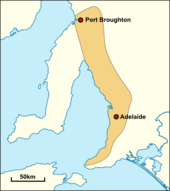William Jervois in a 1882 speech paraphrasing Queen Victoria's royal charter[23]
“願意並規定阿德萊德大學授予任何人,無論男性或女性的藝術、醫學、法律、科學和音樂學位應被視為學術榮譽和功績獎勵,並有權獲得排名、優先權和考慮”
威廉·傑維斯 (William Jervois) 在 1882 年的一次演講中解釋了維多利亞女王的皇家憲章[23]Adelaide (/ˈædɪleɪd/ AD-il-ayd,[8][9] locally [ˈædəlæɪd]; Kaurna: Tardanya, pronounced [ˈd̪̥aɳɖaɲa]) is the capital and most populous city of South Australia,[10] and the fifth-most populous city in Australia. The name "Adelaide" may refer to either Greater Adelaide (including the Adelaide Hills) or the Adelaide city centre. The demonym Adelaidean is used to denote the city and the residents of Adelaide. The traditional owners of the Adelaide region are the Kaurna.[11][12][13] The area of the city centre and surrounding Park Lands is called Tarndanya in the Kaurna language.[14]
Adelaide is situated on the Adelaide Plains north of the Fleurieu Peninsula, between the Gulf St Vincent in the west and the Mount Lofty Ranges in the east. Its metropolitan area extends 20 km (12 mi) from the coast to the foothills of the Mount Lofty Ranges, and stretches 96 km (60 mi) from Gawler in the north to Sellicks Beach in the south.
Named in honour of Queen Adelaide of Saxe-Meiningen, wife of King William IV, the city was founded in 1836 as the planned capital for the only freely-settled British province in Australia.[15] Colonel William Light, one of Adelaide's founding fathers, designed the city centre and chose its location close to the River Torrens. Light's design, now listed as national heritage, set out the city centre in a grid layout known as "Light's Vision", interspaced by wide boulevards and large public squares, and entirely surrounded by park lands.
Early colonial Adelaide was shaped by the diversity and wealth of its free settlers, in contrast to the convict history of other Australian cities. It was Australia's third most populated city until the post-war era. It has been noted for its leading examples of religious freedom and progressive political reforms, and became known as the "City of Churches" due to its diversity of faiths. The city has also been renowned for its automotive industry, as well as being the original host of the Australian Grand Prix in the FIA Formula One World Championship from 1985 to 1995. Today, Adelaide is known by its many festivals and sporting events, its food and wine,[16] its coastline and hills, its large defence and manufacturing sectors, and its emerging space sector, including the Australian Space Agency being headquartered here. Adelaide's quality of life has ranked consistently highly in various measures through the 21st century, at one stage being named Australia's most liveable city, third in the world.[17] Its aesthetic appeal has also been recognised by Architectural Digest, which ranked Adelaide as the most beautiful city in the world in 2024.[18]
As South Australia's government and commercial centre, Adelaide is the site of many governmental and financial institutions. Most of these are concentrated in the city centre along the cultural boulevards of North Terrace and King William Street.
History
[edit]Before European settlement
[edit]
The area around modern-day Adelaide was originally inhabited by the Indigenous Kaurna people, one of many Aboriginal tribes in South Australia. The city and parklands area was known as Tarntanya,[19] Tandanya, now the short name of Tandanya National Aboriginal Cultural Institute, Tarndanya,[20] or Tarndanyangga, now the dual name for Victoria Square, in the Kaurna language.[21] The name means 'male red kangaroo rock', referring to a rock formation on the site that has now been destroyed.[22]
The surrounding area was an open grassy plain with patches of trees and shrubs which had been managed by hundreds of generations. Kaurna country encompassed the plains which stretched north and south of Tarntanya as well as the wooded foothills of the Mt Lofty Ranges. The River Torrens was known as the Karrawirra Pari (Red Gum forest river). About 300 Kaurna populated the Adelaide area, and were referred to by the settlers as the Cowandilla.[23]
There were more than 20 local clans across the plain who lived semi-nomadic lives, with extensive mound settlements where huts were built repeatedly over centuries and a complex social structure including a class of sorcerers separated from regular society.[24]
Within a few decades of European settlement of South Australia, Kaurna culture was almost completely destroyed. The last speaker of Kaurna language died in 1929.[25] Extensive documentation by early missionaries and other researchers has enabled a modern revival of both,[26] which has included a commitment by local and state governments to rename or include Kaurna names for many local places.[27][28]
19th century
----
Australia Highway 1, known as the "Big Lap," is one of the longest highways in the world and extends mostly at the national level, encircling the entire continent.


沒有留言:
張貼留言